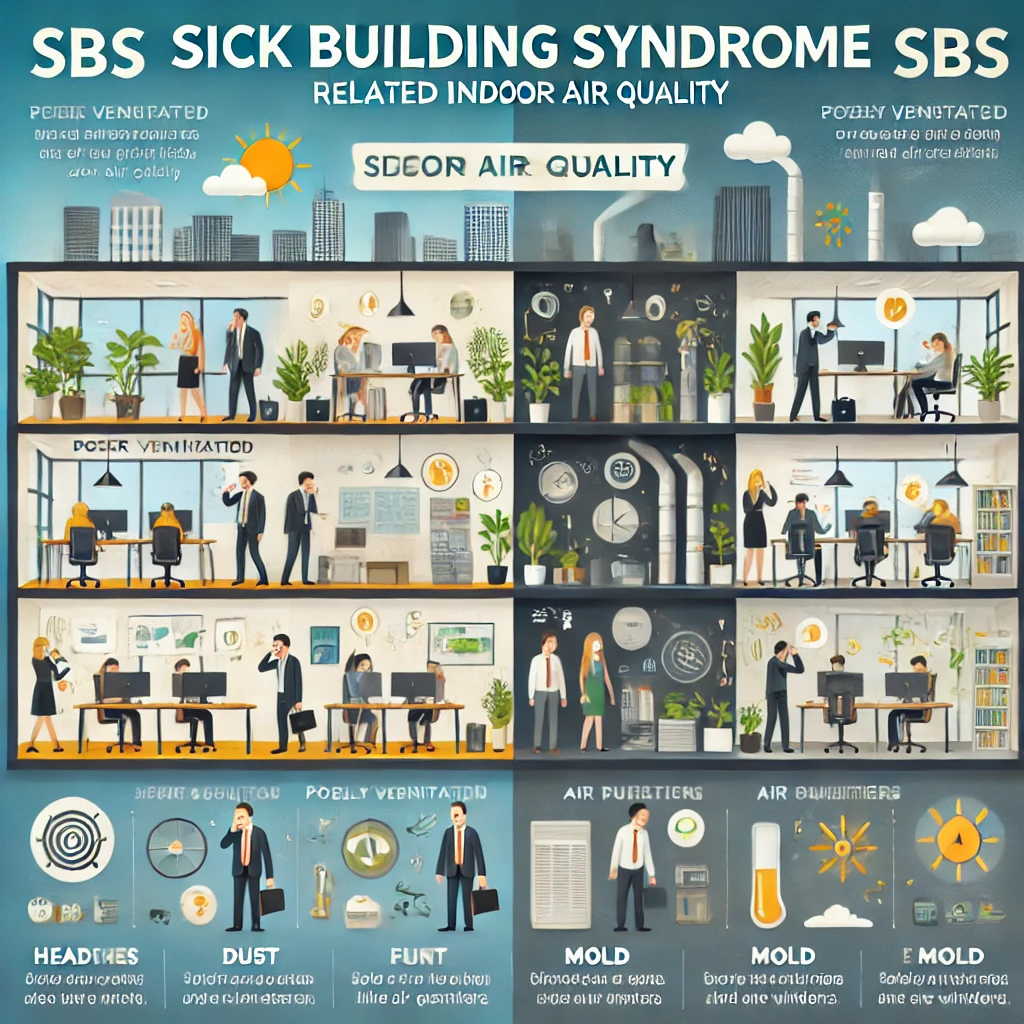Introduction
In today’s fast-paced work environment, many of us spend a significant portion of our lives indoors. While modern buildings are designed to provide comfort and convenience, they can also harbor hidden dangers that affect our health and well-being. One of the most concerning phenomena associated with indoor environments is Sick Building Syndrome (SBS). This blog post explores the causes, symptoms, and solutions to SBS, emphasizing the importance of indoor air quality.
What is Sick Building Syndrome?
Sick Building Syndrome refers to a range of health issues that occupants experience in a particular building, where symptoms typically improve upon leaving the space. While SBS is not a formally recognized medical diagnosis, it encompasses various health complaints that can arise from inadequate indoor air quality.
Common Causes of Sick Building Syndrome
- Poor Ventilation
Adequate ventilation is essential for maintaining good indoor air quality. Buildings that are tightly sealed to improve energy efficiency may restrict airflow, leading to a buildup of indoor pollutants. Insufficient fresh air can exacerbate symptoms of SBS. - Indoor Air Pollutants
Various contaminants can contribute to SBS, including:- Biological contaminants: Mold, bacteria, pollen, and viruses thrive in damp, poorly ventilated environments.
- Chemical pollutants: Emissions from building materials, furniture, and cleaning products can release volatile organic compounds (VOCs) that negatively impact health.
- Dust and particulate matter: Accumulated dust and particles can irritate respiratory systems, leading to discomfort.
- Temperature and Humidity Issues
Maintaining a comfortable temperature and humidity level is crucial for occupant comfort. Extreme conditions can lead to dryness or excessive moisture, creating an environment conducive to mold growth and discomfort.
Symptoms of Sick Building Syndrome
Individuals affected by SBS may experience a variety of symptoms, including:
- Headaches
- Fatigue
- Eye, nose, or throat irritation
- Respiratory issues (e.g., coughing, wheezing)
- Skin irritation
- Nausea
These symptoms can significantly impact productivity and overall quality of life. Moreover, the severity and frequency of symptoms can vary among individuals, making SBS a complex issue to address.
The Importance of Indoor Air Quality
Indoor air quality (IAQ) plays a pivotal role in our health and well-being. Poor IAQ not only contributes to SBS but can also exacerbate pre-existing health conditions, such as asthma or allergies. By understanding the factors affecting IAQ, we can take proactive steps to create healthier indoor environments.
Solutions for Improving Indoor Air Quality
- Enhance Ventilation
Ensure that your building is adequately ventilated. This can be achieved by opening windows, using exhaust fans, or implementing mechanical ventilation systems that introduce fresh air. - Control Humidity Levels
Maintaining humidity levels between 30% and 50% can help prevent mold growth and create a more comfortable environment. Dehumidifiers can be used in areas prone to dampness. - Regular Cleaning and Maintenance
Regularly cleaning and maintaining HVAC systems can help reduce the buildup of dust and pollutants. It’s also essential to promptly address any water leaks or mold growth. - Use Low-Emission Products
When selecting building materials, furnishings, and cleaning products, choose low-VOC or no-VOC options to minimize the release of harmful chemicals into the indoor environment. - Implement Indoor Plants
Certain indoor plants can help improve air quality by absorbing pollutants and releasing oxygen. Incorporating greenery into office spaces can enhance aesthetics and health.
Conclusion
Sick Building Syndrome is a significant public health concern that can affect anyone spending extended periods indoors. By understanding the causes and symptoms associated with SBS and prioritizing indoor air quality, we can create healthier, more productive environments for ourselves and our colleagues.
Let’s advocate for better building practices and indoor air quality awareness, ensuring that our indoor spaces promote well-being and productivity for everyone.
Elevate Your Skills in Building Simulation and CFD with Ecopredict! (https://ecopredict.in/) 🌟
Unlock the power of cutting-edge simulations with our specialized courses in Computational Fluid Dynamics (CFD) and building simulation. At Ecopredict, we offer comprehensive online training designed to equip you with the knowledge and tools necessary for success in the field.
💡 Why Choose Ecopredict?
- Expert-led courses tailored for all skill levels
- Hands-on experience with industry-standard software
- Flexible learning options to fit your schedule
🚀 Join us today and take the next step in your professional journey!
Visit Ecopredict to learn more and start your path to mastering building simulations and CFD.



